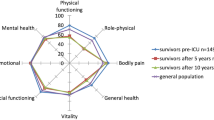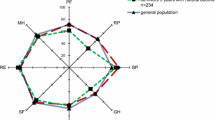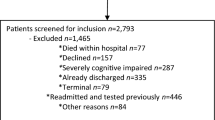Abstract
Objective
To identify factors predictive of good or poor recovery of health status and health-related quality of life (HRQOL) 90 days after admission to an intensive care unit (ICU).
Design and setting
Prospective international multicentre study in 19 ICUs participating in the HRQOL substudy of the SAPS 3 project.
Intervention
The EuroQol questionnaire (EQ) was administered to discharged ICU patients 90 days after admission. A question to compare present health status with that 3 months before ICU admission (same/better/worse) was added.
Patients
Six hundred and eighteen patients who spent > 24 h in an ICU and survived for 90 days. EQ data and health comparison were available in 559 (90.5%) of them.
Measurements and results
Patients reported their general level of health to be better (33.8%), the same (31.1%), or worse (35.1%) in comparison with baseline. Recovery was considered to be good for answers “better” or “the same”. Regression analysis showed that transplantation surgery [odds ratio (OR) 0.07, 95% confidence interval (CI) 0.01–0.63], coronary artery bypass surgery without valvular repair (OR 0.39, 95% CI 0.17–0.92) and being admitted to the ICU from a ward or other location (OR 0.55, 95% CI 0.31–0.95) predicted good recovery of health. Predictors of poor recovery (all present at the time of ICU admission) were unplanned ICU admission, hypothermia, serum creatinine level ≥ 2 mg/dl, pH ≤ 7.25 and metastatic cancer.
Conclusions
More than 60% of ICU patients report good recovery of their health 90 days after ICU admission, depending on their illness and circumstances of ICU admission.

Similar content being viewed by others
References
Consensus Conference organised by the ESICM and the SRLF (1994) Predicting outcome in ICU patients. Intensive Care Med 20:390–397
Angus DC, Carlet J on behalf of the 2002 Brussels Roundtable Participants (2003) Surviving intensive care: a report from the 2002 Brussels Roundtable. Intensive Care Med 29:368–377 DOI 10.1007/s00134-002-1624-8
Curtis JR (2003) Measuring health status after critical illness: where are we and where do we go from here? In: Angus DC, Carlet J (ed) Surviving intensive care. update in intensive care medicine. Springer, Berlin Heidelberg New York, pp 181–196
Metnitz PGH, Moreno RP, Almeida E, Jordan B, Bauer P, Abizanda Campos R, Iapichino G, Edbrooke D, Capuzzo M, Le Gall J-R, on behalf of the SAPS 3 Investigators (2005) SAPS 3 – from evaluation of the patient to evaluation of the ICU. Part 1. Objectives, methods and cohort description. Intensive Care Med 31:1336–1344 DOI 10.1007/s00134-005-2762-6
Moreno RP, Metnitz PGH, Almeida E, Jordan B, Bauer P, Abizanda Campos R, Iapichino G, Edbrooke D, Capuzzo M, Le Gall J-R, on behalf of the SAPS 3 Investigators (2005) SAPS 3 – from evaluation of the patient to evaluation of the ICU. Part 2. Development of a prognostic model for hospital mortality at ICU admission. Intensive Care Med 31:1345–1355 DOI 10.1007/s00134-005-2763-5
The EuroQol Group. (1990) EuroQol – a new facility for the measurement of health-related quality of life. Health Policy 16:199–208
Brazier J, Jones N, Kind P (1993) Testing the validity of the EuroQol and comparing it with the SF health survey questionnaire. Qual Life Res 2:169–180
Van Agt H, Essink-Bot M-L, Krabbe P, Bonsel G (1994) Test – retest reliability of health state valuations collected with the EuroQol questionnaire. Soc Sci Med 39:1537–1544
Kind P, Dolan P, Gudex C, Williams A (1998) Variations in population health status: results from a United Kingdom national questionnaire survey. BMJ 316:736–741
Badia X, Diaz-Prieto A, Rue M, Patrick DL (1996) Measuring health and health state preferences among critically ill patients. Intensive Care Med 22:1379–1384
Badia X, Diaz-Prieto A, Gorriz MT, Herdman M, Torrado H, Farrero E, Cavanilles JM. (2001) Using the EuroQol-5D to measure changes in quality of life 12 months after discharge from an intensive care unit. Intensive Care Med 27:1901–1907 DOI 10.1007/s00134-001-1137-x
Garcia Lizana F, Peres Bota D, De Cubber M, Vincent J-L (2003) Long-term outcome in ICU patients: What about quality of life? Intensive Care Med 29:1286–1293 DOI 10.1007/s00134-003-1875-z
Kaarlola A, Pettila V, Kekki P (2004) Performance of two measures of general health-related quality of life, the EQ-5D and the RAND-36 among critically ill patients. Intensive Care Med 30:2245–2252 DOI 10.1007/s00134-004-2471-6
Orwelius L, Nordlund A, Edéll-Gustafsson U, Simonsson E, Nordlund P, Kristenson M, Bendtsen P, Sjöberg (2005) Role of pre-existing disease in patients' perceptions of health-related quality of life after intensive care. Crit Care Med 33:1557–1564
Brooks R with the EuroQol Group (1996) EuroQol: the current state of play. Health Policy 37:53–72
Granja C, Teixeira-Pinto A, Costa-Pereira A (2002) Quality of life after intensive care: evaluation with EQ-5D questionnaire. Intensive Care Med 28:898–907 DOI 10.1007/s00134-002-1345-z
Needham DM, Dowdy DW, Mendez-Tellez PA, Herridge MS, Pronovost PJ (2005) Studying outcomes of intensive care unit survivors: measuring exposures and outcomes. Intensive Care Med 31:1153–1160 DOI 10.1007/s00134-005-2656-7
Ridley SA, Chrispin PS, Scotton H, Rogers J, Lloyd D (1997) Changes in quality of life after intensive care: comparison with normal data. Anaesthesia 52:195–202
Wehler M, Geise A, Hadzionerovic D, Aljukic E, Reulbach U, Hahn EG, Strauss R (2003) Health-related quality of life of patients with multiple organ dysfunction: individual changes and comparison with normative population. Crit Care Med 31:1094–1101
Vazquez Mata G, Rivera Fernandez R, Gonzales Carmona A, Delgado-Rodriguez M, Torres Ruiz JM, Raya Pugnaire A, Aguayo de Hoyos E (1992) Factors related to quality of life 12 months after discharge from an intensive care unit. Crit Care Med 20:1257–1262
Roset M, Badia X, Mayo NE (1999) Sample size calculations in studies using EuroQol 5 D. Qual Life Res 8:539–549
Artinian NT, Duggan C, Miller P (1993) Age differences in patient recovery patterns following coronary artery bypass surgery. Am J Crit Care 2:453–461
Schulz P, Zimmerman L, Barnason S, Nieveen J (2005) Gender differences in recovery after coronary artery bypass graft surgery. Prog Cardiovasc Nurs 20:58–64
Lindquist R, Dupuis G, Terrin ML, Hoogwerf B, Czajkowski S, Herd JA, Barton FB, Tracy MF, Hunninghake DB, Treat-Jacobson D, Shumaker S, Zyzanski S, Goldenberg I, Knatterud GL; POST CABG Biobehavioral Study Investigators (2003) Comparison of health-related quality-of-life outcomes of men and women after coronary artery bypass surgery through 1 year: findings from the POST CABG Biobehavioral Study. Am Heart J 146:1038–1044
Dowdy DW, Eid MP, Sedrakyan A, Mendez-Tellez PA, Pronovost PJ, Herridge MS, Needham DM (2005) Quality of life in adult survivors of critical illness: a systematic review of the literature. Intensive Care Med 31:611–620 DOI 10.1007/s00134-005-2592-6
Bell D, Turpin K (1994) Quality of life at three months following admission to intensive and coronary care units. Clin Intensive Care 5:276–281
Eddleston JM, White P, Guthrie E (2000) Survival, morbidity, and quality of life after discharge from intensive care. Crit Care Med 28:2293–2299
Kleinpell RM (2003) Exploring outcomes after critical illness in the elderly. Outcomes Manag 7:159–169
Graf J, Koch M, Dujardin R, Kersten A, Janssens U (2003) Health-related quality of life before, 1 month after, and 9 months after intensive care in medical cardiovascular and pulmonary patients. Crit Care Med 31:2163–2169
Cuthbertson BH, Scott J, Strachan M, Kilonzo M, Vale L (2005) Quality of life before and after intensive care. Anaesthesia 60:332–339
Dowdy DW, Needham DM, Mendez-Tellez PA, Herridge MS, Pronovost PJ (2005) Studying outcomes of intensive care unit survivors: the role of the cohort study. Intensive Care Med 31:914–921 DOI 10.1007/s00134-005-2657-6
Crosby RD, Kolotkin RL, Williams GR (2003) Defining clinically meaningful change in health-related quality of life. J Clin Epidemiol 56:395–407
Guadagnoli E, Cleary PD (1995) How consistent is patient-reported pre-admission health status when collected during and after hospital stay? Med Care 33:106–112
Acknowledgements
The SAPS 3 project was endorsed in June 2002 by the European Society of Intensive Care Medicine (ESICM). It received support from the Austrian Centre for Documentation and Quality Assurance in Intensive Care Medicine (ASDI), the Portuguese Society of Intensive Care (SPCI), and the Medical Economics and Research Centre in Sheffield, UK. An unrestricted educational grant from Merck Sharp & Dohme Portugal to the SPCI funded the installation of the Coordination and Communication Centre in Lisbon. iMDsoft (Tel Aviv, Israel), developed and provided free of charge, was the Internet-based data collection software. Statistical analysis was supported by a grant from the Fund of the Austrian National Bank, project 10995 ONB. We thank Eduardo Almeida, who developed the SAPS 3 stand-alone database system, including the variables used in the present substudy. We are grateful to the participating ICUs who made this project possible. We also thank the EuroQol group, who gave us permission to use EQ-5D and provided the appropriate language versions free of charge.
Author information
Authors and Affiliations
Corresponding author
Additional information
The authors wrote this article on behalf of the SAPS 3 Investigators.
Electronic supplementary material
Rights and permissions
About this article
Cite this article
Capuzzo, M., Moreno, R.P., Jordan, B. et al. Predictors of early recovery of health status after intensive care. Intensive Care Med 32, 1832–1838 (2006). https://doi.org/10.1007/s00134-006-0307-2
Received:
Accepted:
Published:
Issue Date:
DOI: https://doi.org/10.1007/s00134-006-0307-2




